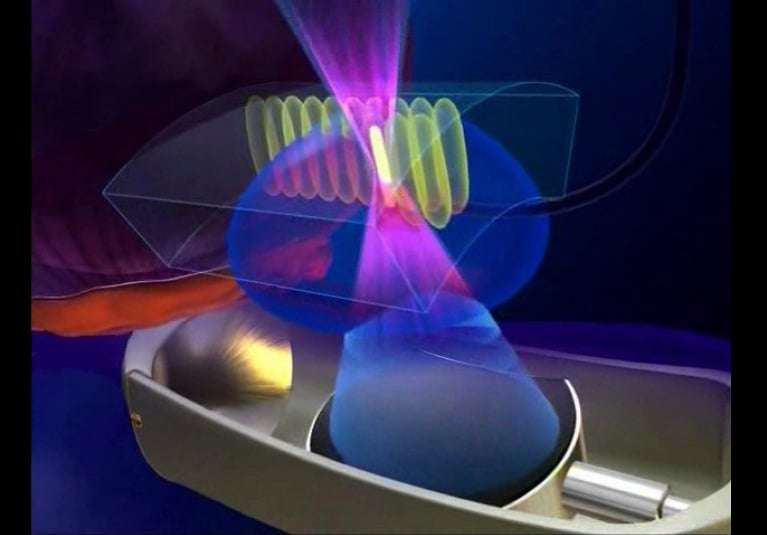Aug. 21, 2021

Derek J. Lomas, M.D., Pharm.D., a urologist and specialist in focal therapy for prostate cancer at Mayo Clinic in Rochester, Minnesota, discusses the addition of high-intensity focused ultrasound (HIFU) to the prostate cancer focal treatment armamentarium.
Provide a little history: How did HIFU progress to a treatment for primary prostate cancer?
The first HIFU prostate cancer clinical trials, completed in the mid-1990s, showed that HIFU could ablate prostate tissue successfully. This finding led to additional studies, and HIFU ultimately entered clinical practice around the world during the following decade.
Initially, HIFU was used to perform whole-gland ablations for prostate cancer. While this application was successful, there was increasing interest in limiting prostate cancer treatment-related side effects by restricting the amount of the prostate that was treated. This treatment approach is termed focal therapy.
The goal of focal therapy is to treat only the area with the most aggressive tumor while leaving the rest of the prostate and its surrounding structures alone. This approach is widely accepted in other types of cancer. For example, we commonly treat kidney cancers by removing or ablating only the tumor while leaving the rest of the kidney intact.
The prostate tumor that is targeted is referred to as the index lesion. In prostates with more than one tumor, this is generally the largest tumor with the highest grade. In these cases, it is believed that the index lesion drives the behavior of the prostate cancer and that treating it alone with focal therapy may lead to good overall cancer control with fewer side effects.
What type of patient is particularly well suited for HIFU?
The ideal candidate for focal therapy typically has intermediate-risk prostate cancer located in only one area of the prostate. This location is determined by prostate magnetic resonance imaging (MRI) and targeted prostate biopsy. My ideal candidate for focal HIFU has a lesion in the posterior or lateral portion of the prostate, a small- to moderate-sized prostate, and no major prostate calcifications or large cysts.
What are the major contraindications to HIFU?
There are a few limitations to HIFU. The first is prostate volume or size. HIFU treatment is delivered through a probe in the rectum, and the treatment can only reach so far away from the rectum. If patients have large prostates and anterior tumors, the energy may not reach anterior enough to provide effective treatment and negative margins. Sometimes tumors in larger prostates can still be treated if the target tumor is in the posterior part of the prostate.
The next limitation is calcifications in the prostate, which are problematic for a couple of reasons. First, the ultrasound energy cannot travel through dense material such as calcifications, so any areas of the prostate behind these may be undertreated. Next, these calcifications can reflect the energy, which could potentially lead to unwanted heat being transferred back to the rectum.
Other potential contraindications include inflammatory bowel disease of the rectum, prior significant rectal surgery, inability to insert the transrectal probe into the rectum, urethral stricture or active infection.
How do you counsel patients who receive HIFU? What is the typical side effect and complication profile? What is the typical recovery?
Overall the focal HIFU procedure is very well tolerated. HIFU is done as an outpatient procedure with a same-day discharge. A Foley catheter is placed during the procedure and is usually left in place for 5 to 7 days following the procedure to allow post-treatment swelling of the prostate to subside.
Once the catheter is removed, most patients do have some temporary obstructive and irritative urinary signs and symptoms including urinary urgency, frequency, slower stream and dysuria. We can manage the signs and symptoms with medications, and patients typically get better within a few weeks.
Rates of new urinary incontinence and erectile dysfunction developing are generally lower than those with prostate removal surgery but are dependent on the location within the prostate being treated. Other side effects that can occur include urinary retention, urinary infection, ejaculatory dysfunction, urethral stricture and rectal fistula (rare).
Most men are able to resume general activities in 1 to 2 days, including regular short walks. More intense physical activity can be resumed once the catheter is removed. There are no incisions to care for or stitches to remove.
Briefly, what are the logistics of the delivery of HIFU?
The HIFU procedure is done while the patient is under general anesthesia. Once the patient is completely anesthetized, a special ultrasound probe is placed in the rectum. There are no incisions or even any needles used. This ultrasound probe is used to both image the prostate and deliver the treatment. Once the initial positioning and planning steps are complete, treatment is delivered.
Each HIFU treatment lasts just a few seconds and destroys an area of tissue that is about the size of a grain of rice. An ablation zone is created by delivering multiple treatments to cover a predefined area of the prostate based on imaging and biopsy results. During the treatment, the surgeon is given real-time imaging as well as treatment parameters including temperature readings and calculated tissue changes to assess the quality and success of ablation. The procedure length depends on the size of the area to be ablated but in general takes approximately two hours.
How do you see HIFU playing a role in prostate cancer treatment over the next 10 years?
I see focal therapy in general becoming an option for more men in the next 10 years as more data supporting its use emerge and more providers become trained in the techniques. HIFU will definitely continue to be one of the main technologies used in prostate cancer focal therapy. There will continue to be ongoing research on other ablation technologies as well. To have a well-rounded focal therapy program, we must have multiple ablation technologies and techniques available to allow for focal therapy to be offered to a wide range of patients. There is still a role for radical prostatectomy and radiation therapy, and certainly they remain the standard of care at this point, but I think focal therapy should at least be part of the treatment discussion in men who are appropriate candidates and seeking a less invasive treatment option.
For some prostate cancer patients, radical treatment (surgery or radiation) are treatment standards. However, these procedures may cause side effects including urinary incontinence or impotency.
A new study from USC Urology with Keck Medicine of USC demonstrates that focal (or targeted) high-intensity focused ultrasound (HIFU) ablation of the prostate is an effective alternative to surgery or radiation, with encouraging outcomes and shortened recovery time.
Focal HIFU ablation is an outpatient procedure that uses a focused ultrasound beam to raise the temperature inside the prostate to approximately 90 degrees Celsius (194 degrees Fahrenheit) to destroy targeted areas of prostate tissue. The procedure takes around two hours and the patients are often discharged home the same day.
The study, published in The Journal of Urology, followed 100 men in the United States who underwent a HIFU procedure for prostate cancer between 2015-2019. This is the first and largest study examining the outcomes of focal HIFU ablation as a primary treatment for prostate cancer in the United States.
During follow-up, 91% of HIFU patients successfully avoided radical treatment. Also, 73% of patients did not experience treatment failure, which the researchers defined as clinically significant cancer recurrence, metastases or mortality, or the need for additional hormone therapy, chemotherapy, surgery or radiation.
The results demonstrated that focal HIFU carries a low risk of complication and can help preserve quality of life. In fact, all patients remained continent and there was no significant decrease in sexual function. There also were no serious adverse events or major complications. Minor complications, including difficulties with urination and urinary tract infection, occurred in a small proportion of the patients, and were addressed without major interventions. Patients were typically discharged the same day as their procedure and resumed regular activities shortly thereafter.
“This positive data empowers urologists to use focal HIFU ablation to effectively address prostate cancer without the intrinsic side effects of radical treatments,” says Andre Abreu, MD, urologic surgeon with Keck Medicine and first author of the study. Abreu is also an assistant professor of clinical urology and radiology at the Keck School of Medicine of USC. “We hope this study encourages prostate cancer patients to talk to their doctor about all potential treatment options to ensure that they receive a personalized care plan that addresses their individual needs.”
Urologists worldwide have used HIFU ablation to treat prostate cancer patients for many years; however, the technology was only approved by the Food and Drug Administration (FDA) for prostate tissue ablation in 2015. Keck Medicine was among the first U.S. institutions to use this technology following the FDA approval.
“USC Urology is dedicated to refining cancer care through collaboration and innovation,” says Inderbir S. Gill, MD, founding and executive director of USC Urology and senior author of the study.
“Throughout screening, diagnosis and treatment, it is important to balance accuracy and efficacy. Our physicians will continue working toward better methods to personalize that balance for every prostate cancer patient,” continues Gill, who is also Distinguished Professor and chair of the Catherine and Joseph Aresty Department of Urology, Shirley and Donald Skinner Chair in Urologic Cancer Surgery and associate dean for clinical innovation at the Keck School.
In 2010, USC Urology launched a focal therapy and image-guided surgery program to develop more accurate methods to diagnose and treat prostate cancer. Since the program’s inception, USC Urology has increased its annual image-guided prostate biopsies six-fold, with the vast majority of these procedures using a combination of MRI and ultrasound imaging. Additionally, USC Urology physicians are skilled in the most innovative therapies, including focal HIFU, cryoablation and robotic prostatectomy.
USC Urology physicians also collaborate with Keck Medicine radiologists and pathologists to create tailored, multidisciplinary treatment plans for each prostate cancer patient.
This year, U.S. News and World Report ranked Keck Medicine No. 9 in the country for Urology.
###
For more information about Keck Medicine of USC, please visit news.KeckMedicine.org.



